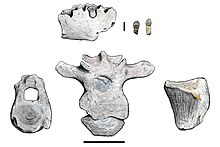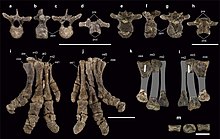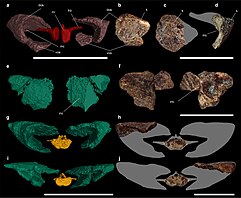Antarctopelta
| Antarctopelta Temporal range: Campanian, Late Cretaceous
| |
|---|---|

| |
| Sketches of the holotype | |
| Scientific classification | |
| Domain: | Eukaryota |
| Kingdom: | Animalia |
| Phylum: | Chordata |
| Clade: | Dinosauria |
| Clade: | †Ornithischia |
| Clade: | †Thyreophora |
| Clade: | †Ankylosauria |
| Clade: | †Parankylosauria |
| Genus: | †Antarctopelta Salgado & Gasparini, 2006 |
| Type species | |
| †Antarctopelta oliveroi Gasparini, 2006 | |
Antarctopelta (
It was a medium-sized ankylosaur, reaching 4 meters (13 feet) in length or more, and showed characteristics of two different families, making more precise classification difficult for many years. This was until 2021, when a nearly complete skeleton of the similar Chilean genus Stegouros was described. This led to the recognition of Parankylosauria, containing Antarctopelta, Stegouros, and Kunbarrasaurus. The head was small, with proportionally large teeth compared to other ankylosaurs' and spikes above the orbits. The neck and back vertebrae were short and circular in cross-section, whereas the tail vertebrae were elongated and flattened. Its tail likely terminated in an arrangement of spiked osteoderms known as a macuahuitl, which resembled an Aztec weapon of the same name. Osteoderms were present on other parts of the body and came in six different shapes, with some being large and flat while others were tall and keeled.
It was discovered in rocks of the Gamma Member of the Snow Hill Island Formation, which bears a variety of other fossils, many of them unique as they evolved in the isolation of Antarctica after the breakup of Gondwana. Antarctopelta coexisted with the ornithopod dinosaur Trinisaura in addition to a menagerie of mosasaurs, plesiosaurs, and sharks.
Discovery and naming

During an expedition to James Ross Island off the coast of Antarctica, an incomplete skeleton of an ankylosaur was discovered by Argentine geologists Eduardo Olivero and Robert Scasso in January 1986. However, excavations would not be finished for a decade due to ground frost and harsh weather conditions. Olivero and Scasso had found the specimen in strata from the Gamma Member of the Snow Hill Island Formation, which dates to the upper Campanian age of the Late Cretaceous period. The material all came from a single individual, but was spread over a 6 square meters (65 square feet) area and collected over several field seasons. The bones were heavily worn due to freeze-thaw weathering, causing many to become fragmented and broken. It was theorized that one of the phalanges came from a different individual,[1] though this has been disproven. At this site, the specimen was unearthed with a tooth of the shark Notidanodon, likely due to scavenging, as well as bivalves. This implies that the ankylosaur died and floated out to sea, a phenomenon observed in other ankylosaurs.[2]
The
Although the material had been known for decades and written about in three separate publications, Antarctopelta oliveroi was not named until 2006, by Argentine

Description

Like other ankylosaurs, Antarctopelta oliveroi was a stocky,
Very little of the skull is known, but all of the preserved skull fragments were heavily ossified for protection. One bone in particular, identified as a supraorbital (brow ridge bone), bore a short spike which would have projected outwards over the eye. Other fossils likely from the quadratojugals (cheek bones), supraorbitals, and right parietal (cranium bone) were identified in 2006, though their poor condition gives little information. The leaf-shaped teeth are asymmetrical, with the majority of the denticles on the edge closest to the tip of the snout and large furrows on the cingula. Seven to eight mesial denticles are found on each Antarctopelta tooth, the highest number known from Parankylosauria, a trait distinguishing it from the related Stegouros.[3] These teeth are also proportionately large compared to those of other ankylosaurs, with the largest measuring 10 millimetres (0.39 inches) across.[4] This compares to the much larger North American Euoplocephalus, 6–7 m (20–23 ft) in body length, which had teeth averaging only 7.5 mm (0.30 in) across.[7] A fragment from the left dentary (lower jaw bone) preserving these teeth was recovered, which has a curved tooth row like other ankylosaurs'.[4]
Postcranium

Five

Six different types of osteoderms were found along with the skeletal remains of Antarctopelta, but very few were articulated with the skeleton, so their placement on the body is largely speculative. They included the base of what would have been a large spike. Flat oblong plates resembled the ones that guarded the neck of the
Classification
Ankylosaurs were a group of herbivorous, quadrupedal ornithischians with armored osteoderms adorning the dermis. Prior to the description of

The following
| |||||||||||||||||||||||||||||||||||||||||||||||||
Paleobiology
Antarctopelta, based on phylogenetic bracketing and known material, probably had a macuahuitl like its relative Stegouros. This structure was made up of several fused, flat osteoderms that occupied the end of the tail. Inside much of the macuahuitl there are no vertebrae, creating a largely fleshy space. The osteoderms are spiked and point outwards in a frond-like pattern, suggesting a defensive function.[3]
Histology

Earlier work suggested that the holotype was a juvenile based on the fusion of bones.[1][11] However, a 2019 histological analysis by Argentine paleontologist Ignacio Cerda and colleagues found that the holotype individual was sexually mature. Samples from three osteoderms, a bone shaft, a metapodial, several undetermined fragments, ossified tendons, and dorsal ribs were used in the study. Based on the spacing and organization of the Outer Circumferential Layer of the bone cortex, Cerda et al concluded that the specimen had reached sexual maturity and was close to adult maturity. During their study, the authors found that one section of bone had an abnormal bone tissue that may have been caused by a tumor or other periosteal reaction. The growth patterns of the bones were not very dissimilar to those of ankylosaurs from lower latitudes. This suggests that the growth rates remained the same, despite different climatic or environmental conditions.[9] This contrasts with hadrosaurs and ceratopsians, which have varying growth rates depending on the latitude.[12][13]
Paleoecology

The
In the Gamma Member, wood fragments, twigs, and leaves have been found in concretions, some being associated with dinosaur fossils like Antarctopelta itself, and were apparently transported by the same ocean currents that brought the dinosaur carcasses. From the Gamma Member,
See also
- Timeline of ankylosaur research
- South Polar dinosaurs
References
- ^ a b c Olivero, E.; Gasparini, Z.; Rinaldi, C.; Scasso, R. (1991). "First record of dinosaurs in Antarctica (Upper Cretaceous, James Ross Island): paleogeographical implications". In Thomson, M.R.A.; Crame, J.A.; Thomson, J.W. (eds.). Geological Evolution of Antarctica. Cambridge: Cambridge University Press. pp. 617–622.
- ISSN 0031-0182.
- ^ S2CID 244799975.
- ^ a b c d e f g h i j Salgado, L.; Gasparini, Z. (2006). "Reappraisal of an ankylosaurian dinosaur from the Upper Cretaceous of James Ross Island (Antarctica)" (PDF). Geodiversitas. 28 (1): 119–135. Archived (PDF) from the original on 2023-05-21.
- S2CID 38933265.
- ^ Paul, Gregory S. (2010). The Princeton Field Guide to Dinosaurs. New Jersey: Princeton University Press. p. 230.
- ^ Vickaryous, M.K.; Maryanska, T.; Weishampel, D.B. (2004). "Ankylosauria". In Weishampel, D.B.; Dodson, P.; Osmólska, H. (eds.). The Dinosauria (Second ed.). Berkeley: University of California Press. pp. 363–392.
- ^ S2CID 244830406.
- ^ S2CID 199112893.
- S2CID 86002282.
- ^ Gasparini, Z.; Pereda-Suberbiola, X.; Molnar, R.E. (1996). "New data on the ankylosaurian dinosaur from the Late Cretaceous of the Antarctic Peninsula". Memoirs of the Queensland Museum. 39: 583–594.
- PMID 31862946.
- S2CID 225028518.
- ^ S2CID 249359371.
- ^ Smith, N. D., Makovicky, P. J., Pol, D., Hammer, W. R., & Currie, P. J. (2007). The dinosaurs of the Early Jurassic Hanson Formation of the central Transantarctic Mountains: phylogenetic review and synthesis. US Geological Survey and the National Academies, Short Research Paper, 3.
- S2CID 249359371.
- ^ Lamanna, Matthew; Case, Judd; Roberts, Eric; Arbour, Victoria (2019). "Late Cretaceous non-avian dinosaurs from the James Ross Basin, Antarctica: description of new material, updated synthesis, biostratigraphy, and paleobiogeography". Advances in Polar Science. 30 (3): 228–250.
- ^ Horner, J.R. (1979). "Upper Cretaceous dinosaurs from the Bearpaw Shale (Marine) of southcentral Montana, with a checklist of Upper Cretaceous dinosaur remains from marine sediments in North America". Journal of Paleontology. 53 (3): 566–577.
- .
- .
- PMID 26261324.
- S2CID 85566126.
- S2CID 253637977.
- ISSN 0002-7014.
- ^ Martin, J. E., Bell Jr, G. L., Case, J. A., Chaney, D. S., Fernández, M. A., Gasparini, Z., ... & Woodburne, M. O. (2002). Mosasaurs (Reptilia) from the Late Cretaceous of the Antarctic peninsula. In Antarctica at the Close of a Millennium, Eighth International Symposium on Antarctic Earth Sciences. Royal Society, New Zealand Bulletin (Vol. 35, pp. 293-299).
- S2CID 129447475.
- ^ Otero, R. A., Gutstein, C. S., Vargas, A., Rubilar-Rogers, D., Yury-Yañez, R., Bastías, J., & Ramírez, C. (2014). New chondrichthyans from the Upper Cretaceous (Campanian–Maastrichtian) of Seymour and James Ross islands, Antarctica. Journal of Paleontology, 88(3), 411-420.
